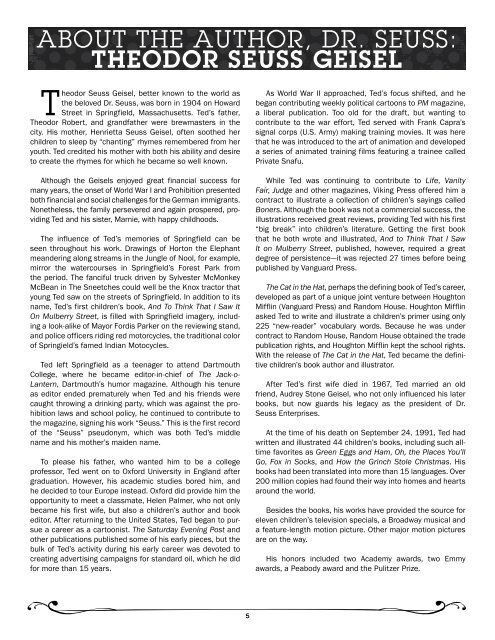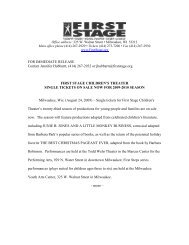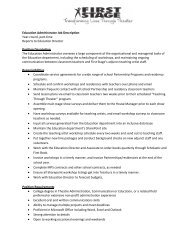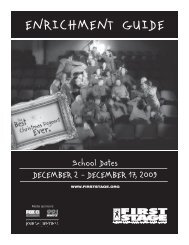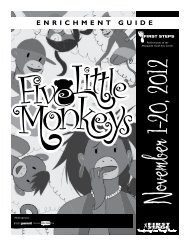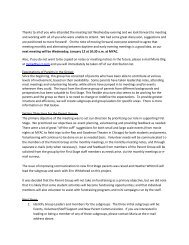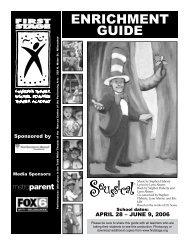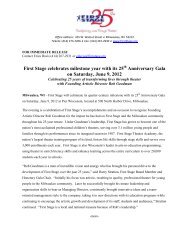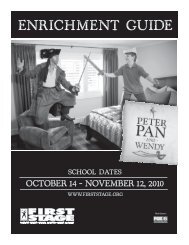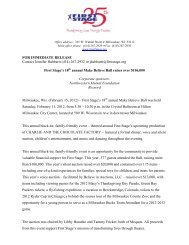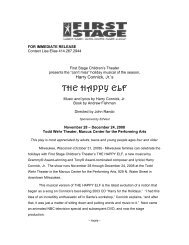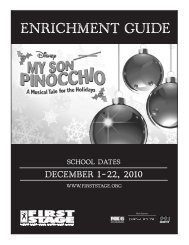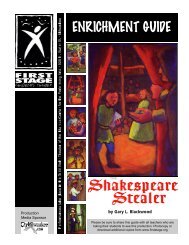SeuSSicAl - First Stage
SeuSSicAl - First Stage
SeuSSicAl - First Stage
- No tags were found...
You also want an ePaper? Increase the reach of your titles
YUMPU automatically turns print PDFs into web optimized ePapers that Google loves.
About The Author, Dr. Seuss:Theodor Seuss GeiselTheodor Seuss Geisel, better known to the world asthe beloved Dr. Seuss, was born in 1904 on HowardStreet in Springfield, Massachusetts. Ted’s father,Theodor Robert, and grandfather were brewmasters in thecity. His mother, Henrietta Seuss Geisel, often soothed herchildren to sleep by “chanting” rhymes remembered from heryouth. Ted credited his mother with both his ability and desireto create the rhymes for which he became so well known.Although the Geisels enjoyed great financial success formany years, the onset of World War I and Prohibition presentedboth financial and social challenges for the German immigrants.Nonetheless, the family persevered and again prospered, providingTed and his sister, Marnie, with happy childhoods.The influence of Ted’s memories of Springfield can beseen throughout his work. Drawings of Horton the Elephantmeandering along streams in the Jungle of Nool, for example,mirror the watercourses in Springfield’s Forest Park fromthe period. The fanciful truck driven by Sylvester McMonkeyMcBean in The Sneetches could well be the Knox tractor thatyoung Ted saw on the streets of Springfield. In addition to itsname, Ted’s first children’s book, And To Think That I Saw ItOn Mulberry Street, is filled with Springfield imagery, includinga look-alike of Mayor Fordis Parker on the reviewing stand,and police officers riding red motorcycles, the traditional colorof Springield’s famed Indian Motocycles.Ted left Springfield as a teenager to attend DartmouthCollege, where he became editor-in-chief of The Jack-o-Lantern, Dartmouth’s humor magazine. Although his tenureas editor ended prematurely when Ted and his friends werecaught throwing a drinking party, which was against the prohibitionlaws and school policy, he continued to contribute tothe magazine, signing his work “Seuss.” This is the first recordof the “Seuss” pseudonym, which was both Ted’s middlename and his mother’s maiden name.To please his father, who wanted him to be a collegeprofessor, Ted went on to Oxford University in England aftergraduation. However, his academic studies bored him, andhe decided to tour Europe instead. Oxford did provide him theopportunity to meet a classmate, Helen Palmer, who not onlybecame his first wife, but also a children’s author and bookeditor. After returning to the United States, Ted began to pursuea career as a cartoonist. The Saturday Evening Post andother publications published some of his early pieces, but thebulk of Ted’s activity during his early career was devoted tocreating advertising campaigns for standard oil, which he didfor more than 15 years.As World War II approached, Ted’s focus shifted, and hebegan contributing weekly political cartoons to PM magazine,a liberal publication. Too old for the draft, but wanting tocontribute to the war effort, Ted served with Frank Capra’ssignal corps (U.S. Army) making training movies. It was herethat he was introduced to the art of animation and developeda series of animated training films featuring a trainee calledPrivate Snafu.While Ted was continuing to contribute to Life, VanityFair, Judge and other magazines, Viking Press offered him acontract to illustrate a collection of children’s sayings calledBoners. Although the book was not a commercial success, theillustrations received great reviews, providing Ted with his first“big break” into children’s literature. Getting the first bookthat he both wrote and illustrated, And to Think That I SawIt on Mulberry Street, published, however, required a greatdegree of persistence—it was rejected 27 times before beingpublished by Vanguard Press.The Cat in the Hat, perhaps the defining book of Ted’s career,developed as part of a unique joint venture between HoughtonMifflin (Vanguard Press) and Random House. Houghton Mifflinasked Ted to write and illustrate a children’s primer using only225 “new-reader” vocabulary words. Because he was undercontract to Random House, Random House obtained the tradepublication rights, and Houghton Mifflin kept the school rights.With the release of The Cat in the Hat, Ted became the definitivechildren’s book author and illustrator.After Ted’s first wife died in 1967, Ted married an oldfriend, Audrey Stone Geisel, who not only influenced his laterbooks, but now guards his legacy as the president of Dr.Seuss Enterprises.At the time of his death on September 24, 1991, Ted hadwritten and illustrated 44 children’s books, including such alltimefavorites as Green Eggs and Ham, Oh, the Places You’llGo, Fox in Socks, and How the Grinch Stole Christmas. Hisbooks had been translated into more than 15 languages. Over200 million copies had found their way into homes and heartsaround the world.Besides the books, his works have provided the source foreleven children’s television specials, a Broadway musical anda feature-length motion picture. Other major motion picturesare on the way.His honors included two Academy awards, two Emmyawards, a Peabody award and the Pulitzer Prize.5


